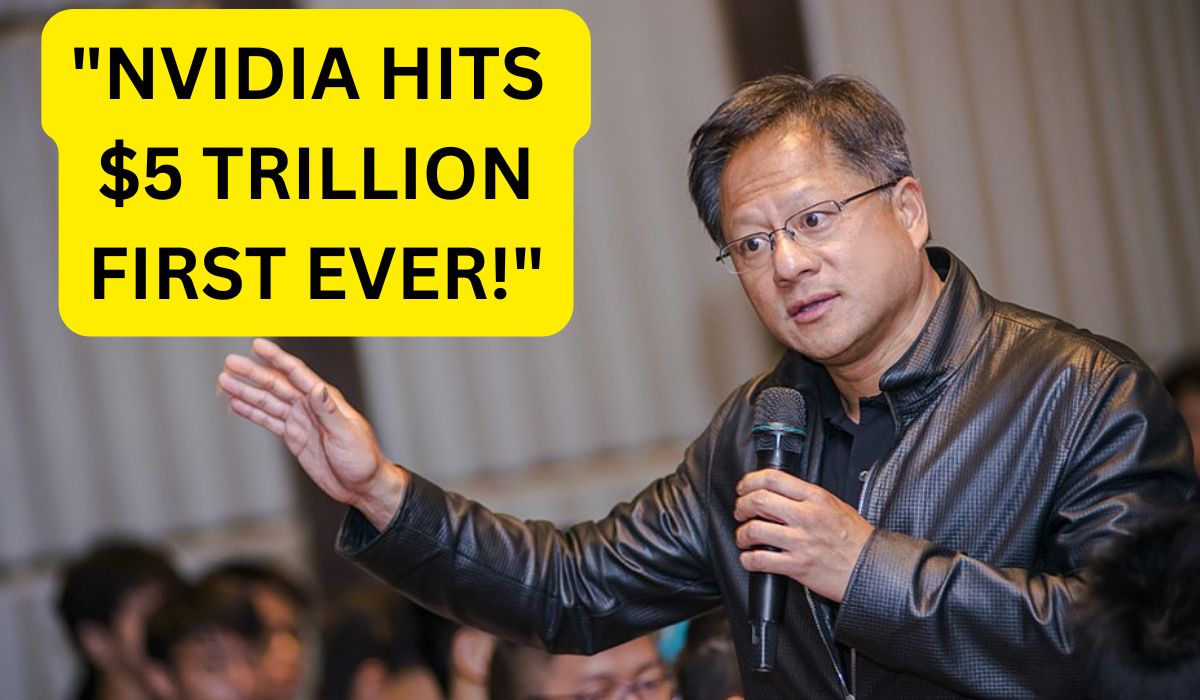Nvidia made financial history Wednesday by becoming the first company ever to reach a $5 trillion market valuation, marking an extraordinary achievement for the artificial intelligence chip manufacturer that continues to dominate the rapidly expanding AI sector.
The Historic Market Milestone
The breakthrough came during Wednesday’s trading session when Nvidia shares increased by 3.4% following strong pre-market momentum. The stock surge pushed the company’s market capitalization from approximately $4.89 trillion to $5.06 trillion, establishing a new intraday high and cementing Nvidia’s position as the world’s most valuable publicly traded company.
What makes this development particularly significant is the speed at which Nvidia has achieved this valuation. The company was valued at just over $10 billion in 2015, but rapidly became the world’s most valuable company as demand for AI software and hardware skyrocketed. This represents an unprecedented expansion in corporate value driven primarily by the explosion of artificial intelligence applications across industries.
Nvidia now ranks ahead of technology giants Microsoft and Apple, both of which recently crossed the $4 trillion threshold on October 28th. The company also surpasses Google parent Alphabet, Amazon, and Meta in market valuation.
Driving Forces Behind the Valuation Surge
Several key factors converged to push Nvidia past this historic $5 trillion mark. CEO Jensen Huang‘s announcement that the company expects $500 billion in AI chip orders, combined with Nvidia’s plans to build seven supercomputers for the US government, sent a powerful signal to investors about the company’s future revenue pipeline.
The customer base tells the story of AI’s current landscape. Among Nvidia’s largest customers are OpenAI, Elon Musk‘s Tesla and XAI, Meta, Amazon, and Oracle. These partnerships demonstrate Nvidia’s central position in the AI infrastructure ecosystem, providing the computational backbone for everything from generative AI models to autonomous vehicle development.
Adding to investor enthusiasm, Nvidia announced Tuesday it would take a $1 billion stake in Nokia, creating a new partnership with the networking firm to develop next generation 6G technology. This move signals Nvidia’s strategic expansion beyond AI chips into future telecommunications infrastructure, opening another substantial growth avenue.
A Decade of Extraordinary Returns
Looking at Nvidia’s performance over the past ten years reveals one of the most remarkable wealth creation stories in market history. Nvidia’s stock has climbed more than 44,000% over the last decade, outpacing the NASDAQ and S&P over the same period.
To put this in perspective: A $1,000 investment in Nvidia when shares hit a low of 47 cents a share in February of 2015, would now be worth $441,000. This represents a 441x return in just under a decade, far exceeding the performance of traditional market indices and most actively managed funds.
The scale of this appreciation reflects not just company execution but the broader transformation of the technology landscape. What began as a graphics processing unit (GPU) manufacturer for gaming has evolved into the essential infrastructure provider for the AI revolution.
The Wealth Effect
The company’s meteoric rise has created substantial personal wealth for its leadership. CEO Jensen Huang, who holds roughly 3% equity in Nvidia, has a net worth estimated at $174.4 billion, ranking him the eighth richest person in the world. His fortune has grown in lockstep with Nvidia’s market surge, demonstrating how equity ownership in transformative technology companies can generate unprecedented wealth.
Interestingly, the ripple effects extend throughout the tech ecosystem. The similar market rise of Nvidia’s customers has boosted the net worth of Oracle chairman Larry Ellison to challenge Elon Musk as the world’s richest person, illustrating how interconnected wealth creation has become in the AI era.
Market Implications and What’s Next
Nvidia’s achievement of the $5 trillion milestone raises important questions about valuation sustainability and market concentration. The company’s dominance in AI chip manufacturing gives it near-monopolistic positioning in one of technology’s fastest-growing segments. However, this also presents potential risks if competition intensifies or if AI adoption cycles prove less durable than current projections suggest.
The $500 billion in expected AI chip orders provides significant revenue visibility, but investors will watch closely to see if demand continues at this pace or begins to moderate as initial AI infrastructure buildouts complete. The government supercomputer contracts add a stable revenue base with national security implications, potentially insulating some portion of Nvidia’s business from typical market cycles.
The Nokia partnership and 6G development initiative indicate management’s awareness that diversification beyond current AI chip dominance will be essential for sustaining long-term growth. As 6G technology emerges over the next decade, Nvidia is positioning itself to play a central role in that infrastructure transition.
The key question going forward: Can Nvidia maintain its extraordinary growth trajectory, or has the stock’s 44,000% decade-long run created valuation levels that will be difficult to justify as AI market dynamics inevitably shift? With the company now valued at more than the entire GDP of most nations, the stakes for both Nvidia and broader market indices have never been higher.
